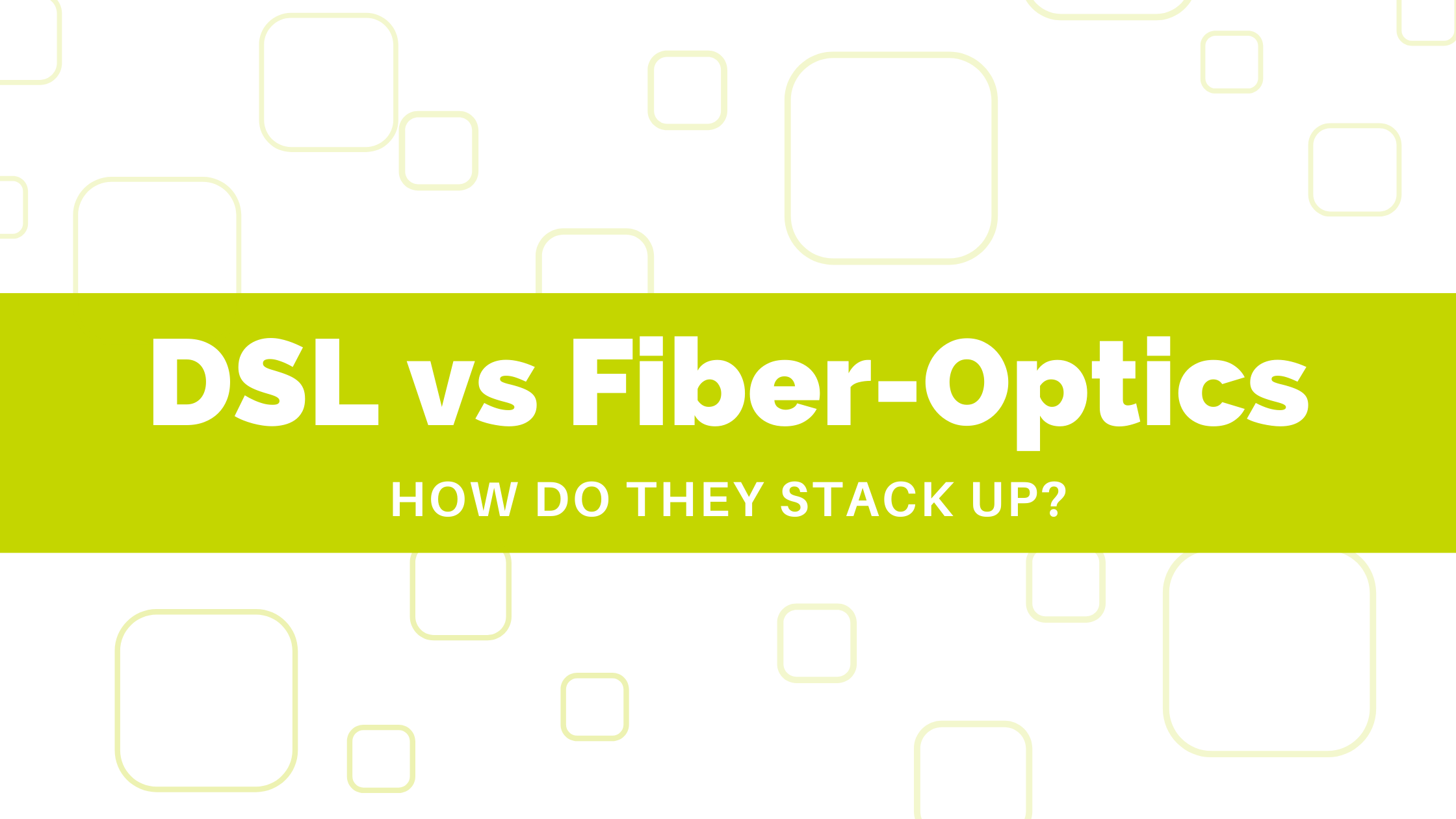DSL vs Fiber. How Do They Stack Up?
The internet is such a big part of everyday life it’s hard to believe that it didn’t become mainstream until the 1990s! Even more amazing is how far internet technology has come in such a short time. The way in which we connect to the internet has progressed leaps and bounds from the original dial-up connection, with DSL and fiber-optic being the most popular connection types today. With all that being said we wanted to take you on a deep dive into DSL and fiber so you can be better informed on the connection that is best for your needs!
What is Fiber?
Fiber is a relatively new technology for the internet. Made from thin glass strands, fiber-optic internet utilizes pulsing light to transmit and receive data. It is the fastest form of internet connection to date with speeds of up to 100 Gbps.
What is DSL?
DSL stands for digital subscriber line. It utilizes existing copper telephone-line infrastructure and electricity to transmit data. If you remember the dial-up internet days, DSL uses those same lines only now you can make a call and use the internet at the same time. Since DSL uses an older outdated technology speeds are usually low and not as reliable, especially in rural communities.
Now that you know the basic definitions of both forms of internet connection let’s go over the details.
Fiber Overview
Speeds – When it comes to internet connection nothing beats fiber in terms of speed. Fiber internet utilizes glass strands and light to transmit data, which can travel much faster than the copper wire and electricity that DSL uses. Most fiber internet providers offer speeds from 250 Mbps to 100 Gbps. With fiber internet, you also get symmetrical upload and download speeds so you don’t have to worry about your connection whether you’re watching a show or uploading a video.
Availability – Fiber is a relatively new technology in the internet world so there is limited availability while companies build out new fiber-optic infrastructure. That being said, the industry has boomed in recent years and fiber is becoming more readily available everyday!
Price – Fiber prices vary by provider, but with UTOPIA Fiber residential prices start at $65 for 250 Mbps and go up to $230 for 10 Gbps. Learn more about our residential pricing here. Business prices vary. Contact our business department to learn more.
Reliability – When it comes to reliability fiber is at the top of its game. Fiber-optics may seem fragile because they are made out of glass, but they are actually extremely durable. Since they aren’t made from metal they are less likely to be influenced by harsh weather conditions and temperature changes. They also last longer than copper wires. Since they carry light and not electricity they do not use electromagnetic currents that cause copper wires to deteriorate quickly.
DSL Overview
Speeds – DSL internet utilizes old copper telephone lines and electricity to transmit data. This is slower than fiber and most cable connections. Most DSL speeds generally don’t go higher than 100 Mbps but can go up to 400 Mbps. With DSL, you also don’t get symmetrical upload and download speeds, you may get 100 Mbps download speeds but upload speeds generally don’t go higher than 8 Mbps.
Availability – Because DSL utilizes old telephone lines from dial-up/landline days, it has wide availability.
Price – For DSL most plans start at $40 for 50 Mbps and can go up to $70 for 45 Mbps depending on the provider you choose.
Reliability – Since DSL utilizes existing telephone line infrastructure it has copper wires. Copper wires are more susceptible to weather conditions and temperature changes which can cause them to be brittle and break. They also use electricity to transmit data which has electromagnetic currents that will cause copper to deteriorate quickly. Both of these factor into more maintenance and more outages. Your speed also depends on how close you are to your actual provider, the further away you are the slower your connection.
Key Takeaways:
DSL – Pros & Cons
Pros – largely available, easy installation
Cons – Slower speeds, high price for speeds you are getting, copper wire lifespan.
Fiber Pros & Cons
Pros- high speeds, symmetrical upload and download speeds, good cost for speeds you are getting, professional install, security, reliability.
Cons – not widely available yet, construction disruptions.
Final Thoughts:
DSL is an outdated technology where its greatest pull is its current widespread availability. It was great for the time and a necessary stepping stone in the internet connection’s progression. Fiber is a newer internet technology that is working on its infrastructure to become more widespread. It has better speeds for the price you pay, and you are guaranteed to get the speeds you are paying for uploads and downloads. It is also nice to know that fiber cables are durable and less susceptible to outages! In short, fiber is the internet of the future with the capability to keep up with technology as it progresses.
What do you think? Is fiber the future or do you prefer DSL? Let us know on our social media what you think! If you are interested in upgrading to a fiber connection you can sign up for UTOPIA Fiber here.
